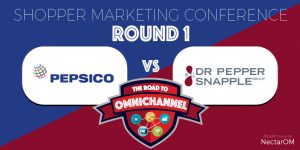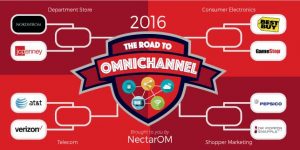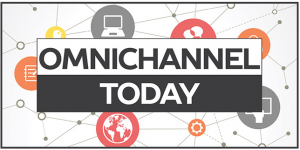The 2016 NectarOM Road to Omni Channel Tournament kicked off with two titans of refreshment squaring off to show which shopper marketing heavyweight was best positioned to win in the fast approaching world of ecommerce, omni channel, and data-driven marketing. Unfortunately for Texas stalwart, Dr Pepper Snapple Group, NY-based PepsiCo beat them so badly it will go down as one of the worst blow outs this year with a final score of 102 – 68.
The Play-By-Play
Both institutions are at a distinct disadvantage compared to the more established “conferences” like retail that have transactional data, but they’ve both invested heavily in their digital channels and are beginning to resemble the more established competitors. That said, it’s clear Dr Pepper Snapple Group is closer to cardboard and end-caps than omni channel and personalization. It looked like Dr Pepper was going to have a bright spot in the game when they used the Batman v Superman movie promotion introduce image recognition and can packaging to access extended comic content. Unfortunately, it was very similar to the program Frito Lay did with DC Comics for the Green Lantern movie back in 2011 so they saw the play coming a mile away. Aside from that, the only other player Dr Pepper had involved in the scoring was Email and it’s numbers were very pedestrian showing off nothing more than a batch and blast style.
PepsiCo, however, quieted a lot of critics with their performance. They played with a chip on their shoulder showing a Consumer Packaged Goods company could hang with any team. The PepsiCo enterprise website made some fans right from the start with a little known program that allowed people to sign up for the “Brands You Love.” While there were a few missed assist opportunities in how they could use that self-reported data, we were impressed with the attempt. That start put Dr Pepper Snapple Group on their heels for the rest of the game.
Once you moved beyond the enterprise site you couldn’t help but be impressed by the other starters on Pepsico’s roster. There was the “Find Your Match” function on the PepsiCo Beverage Facts site which offered some pretty cool functionality and exposed us to their potential. Room for improvement, but extreme potential was a reoccurring theme when compared the Beverage Facts site with Frito Lay’s loyalty program equivalent, Snack Perks. While they didn’t work well together you could see how they will eventually click and when they do it will make a big impact. PepsiCo’s recent ecommerce tests and hires, their recently launched Hello Goodness vending strategy and past innovations like Social Vending have also contributed to the company’s omni channel future by giving the enterprise direct access to the purchase process.
You would expect both organization’s promotions to provide some bench support. From an omni channel perspective it was consistent, but surprisingly average. Social channels were heavily employed by both companies and the content was available in multiple channels, but there was no sense of personalization or recognition of the participants beyond operational tracking like how many times you entered. At the end of the game it was clear the real stars of the game were PepsiCo’s evergreen programs which are destined for the pros.
Key Stats
Examining how the teams did at applying omni channel strategies and personalization techniques we realize this was really a difference of players over play. For the most part, PepsiCo just brought better athletes, but there were some great areas where the play was elevated …
- Cross Channel Experiences – If you look at how both teams passed visitors between channels it was fundamentally strong in promotions, but there were way too many turnovers in the evergreen efforts where they could have connected the consumer to the entire portfolio.
- Operations – Just like free throws in a basketball game, missing basic messaging and channel follow through can ruin an experience. Neither team performed well in this fundamental area and for up-and-coming conferences like Shopper Marketing it’s a requirement.
- Recognition – Both teams did a good job finding ways to recognize visitors, but PepsiCo definitely took it to a new level with understanding the visitor’s preferences.
- Consumer Journey – Looking to the future, it’s clear PepsiCo’s made a commitment to understanding the consumer’s journey. Using location-based retargeting, personal preference programs and portfolio solutions over brand promotions were all areas where they excelled.
- Recommendations – If you were going to pick one statistics category that put PepsiCo in a different league than Dr Pepper Snapple Group it would be in this category. Their focus is on bringing a flavor or product solution to their customers based on whatever they are doing and it really paid off in this game.
Conclusion
If Dr Pepper Snapple Group ever hopes to make a run in this tournament in future years they will have to focus on the basics – great channel execution, namely mobile, and commit to an omni channel approach. Their promotional approach has been done for years and it limits their ability to create a real connection with their fans. Today they look a little like the mid-major competitors Vanderbilt or Monmouth in that other tournament – a solid program, but always on the bubble and running the risk of being left out of the tournament.
PepsiCo, on the other hand, looks reminiscent of those programs on the cusp of something special like a University of Texas or an Iowa State University. They’ve assembled great talent, they’re well coached, they work together as a team, but consistency will be their undoing. Getting to that consistency is easier said than done considering the brands in the portfolio are used to playing by their own rules.
Changes in Pepsico’s Digital and Shopper Marketing has helped everyone understand they’re “better together,” but will it sustain them against the powerhouse conferences like Retail or Telco? We’ll have to see, but they are certainly off to a good start after this first game.
Tune in here for Game Two: //nectarom.com/telecom-conference/











